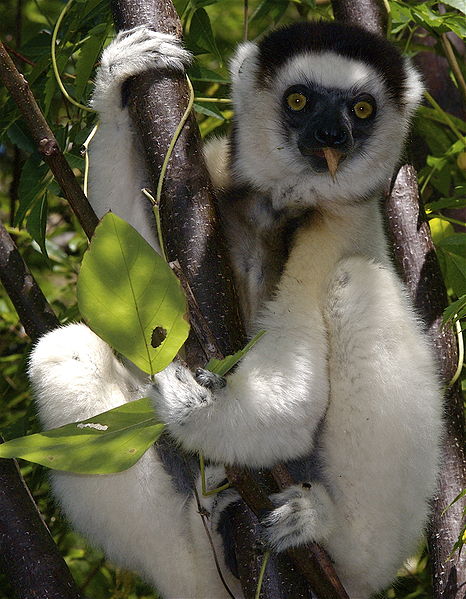AIR QUALITY WORLD MAP
http://aqicn.org/map/world#@g/17.5707/3.7217/2z
AIR COMPOSITION
http://www.bbc.co.uk/education/guides/zt6g87h/activity
EVOLUTION
http://www.bbc.co.uk/bitesize/quiz/q20608582
http://eschooltoday.com/pollution/air-pollution/what-is-air-pollution.html
Showing posts with label CLIMATE CHANGE. Show all posts
Showing posts with label CLIMATE CHANGE. Show all posts
Thursday, May 7, 2015
Differences between solids, liquids and gases:
http://www.bbc.co.uk/bitesize/ks2/science/materials/solids_liquids_gases/read/1/
LAYERS OF THE ATMOSPHERE:
http://www.windows2universe.org/earth/Atmosphere/layers.html
AIR POLLUTION:
http://www.windows2universe.org/earth/Atmosphere/airpollution_intro.html
http://www.bbc.co.uk/bitesize/ks2/science/materials/solids_liquids_gases/read/1/
LAYERS OF THE ATMOSPHERE:
http://www.windows2universe.org/earth/Atmosphere/layers.html
AIR POLLUTION:
http://www.windows2universe.org/earth/Atmosphere/airpollution_intro.html
Thursday, April 30, 2015
NASA'S CLIMATE KIDS
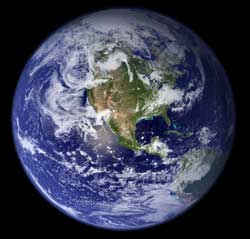 After all, we live on land.
After all, we live on land.
But our world is a water world. The ocean covers 70% of Earth's surface. The average depth of the ocean is about 2.7 miles. In some places, the ocean is deeper than the tallest mountains are high! The ocean contains about 97% of all the water on Earth.
The ocean plays a starring role in whatever happens with the environment. One big part of its role is to soak up energy (heat) and distribute it more evenly around the Earth. Another part is to soak up CO2.
.http://climatekids.nasa.gov/ocean/

The ocean does an excellent job of absorbing excess heat from the atmosphere. The top few meters of the ocean stores as much heat as Earth's entire atmosphere. So, as the planet warms, it's the ocean that gets most of the extra energy.
But if the ocean gets too warm, then the plants and animals that live in it must adapt—or die.
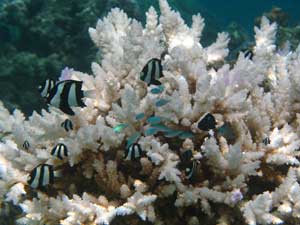
This coral has lost its algae, and thus its food source. It is sick and will probably die.
The ocean is great at sucking up CO2 from the air. It absorbs about one-quarter of the CO2 that we humans create when we burn fossil fuels (oil, coal, and natural gas.) If not for the ocean, we'd be in even worse trouble with too much CO2.
However, the ocean and everything in it are paying a price. The ocean is becoming more acidic.
What does this mean? Liquids are either acid or alkaline. Each liquid falls somewhere along a scale with acid at one end and alkaline at the other.

However, when the ocean absorbs a lot of CO2, the water becomes more acidic. The alkalinity of the ocean is very important in maintaining a delicate balance needed for animals to make protective shells. If the water is too acidic, the animals may not be able to make strong shells. Corals could also be affected, since their skeletons are made of the same shell-like material.
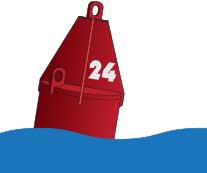
One way the ocean affects the climate in places like Europe is by carrying heat to the north in the Atlantic Ocean. Way up north, cold water in the North Atlantic ocean sinks very deep and spreads out all around the world. The sinking water is replaced by warm water near the surface that moves to the north. Scientists call this the Great Ocean Conveyor Belt. The heat carried north helps keep the Atlantic ocean warmer in the winter time, which warms the nearby countries as well.
NASA missions that very accurately measure the hills and valleys in the ocean and changes in sea level help scientists understand what is happened with ocean currents.
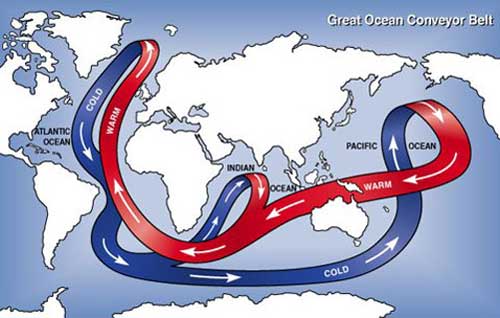 The "great ocean conveyor belt" refers to the major
ocean currents that move warm water from the equator to the poles and
cold water from the poles back toward the equator
The "great ocean conveyor belt" refers to the major
ocean currents that move warm water from the equator to the poles and
cold water from the poles back toward the equator
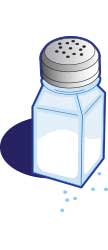
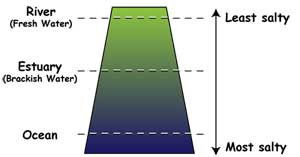 The amount of salt in the ocean water also affects currents. Saltier
water is heavier than less salty water. When salty ocean water freezes,
the ice can no longer hold on to the salt. Instead, the salt mixes with
the water below making it saltier and heavier. Glaciers, land ice and
icebergs are made of fresh water, so what happens when this ice melts?
Good question!
The amount of salt in the ocean water also affects currents. Saltier
water is heavier than less salty water. When salty ocean water freezes,
the ice can no longer hold on to the salt. Instead, the salt mixes with
the water below making it saltier and heavier. Glaciers, land ice and
icebergs are made of fresh water, so what happens when this ice melts?
Good question!
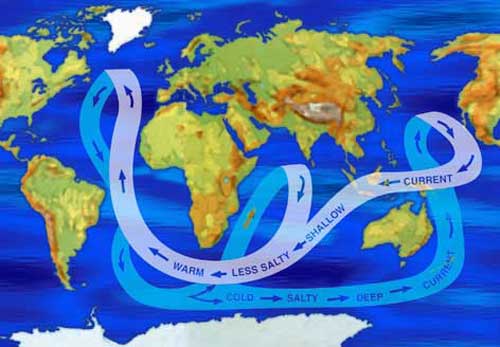 The water in the North Atlantic sinks because it's cold, but also
because it's salty. Being both cold AND salty makes it really heavy, so
it can sink very far. But if too much ice melts in the North Atlantic,
the water could become less salty. If that happens, what about the
Ocean Conveyor Belt? Would it stop warming the North Atlantic? Could
Europe get really cold? Scientists say it seems unlikely, but NASA
satellites are keeping a close eye on the melting ice and the ocean
currents to try to understand this complicated system better.
The water in the North Atlantic sinks because it's cold, but also
because it's salty. Being both cold AND salty makes it really heavy, so
it can sink very far. But if too much ice melts in the North Atlantic,
the water could become less salty. If that happens, what about the
Ocean Conveyor Belt? Would it stop warming the North Atlantic? Could
Europe get really cold? Scientists say it seems unlikely, but NASA
satellites are keeping a close eye on the melting ice and the ocean
currents to try to understand this complicated system better.
Why is the ocean important?

Our watery world.
But our world is a water world. The ocean covers 70% of Earth's surface. The average depth of the ocean is about 2.7 miles. In some places, the ocean is deeper than the tallest mountains are high! The ocean contains about 97% of all the water on Earth.
The ocean plays a starring role in whatever happens with the environment. One big part of its role is to soak up energy (heat) and distribute it more evenly around the Earth. Another part is to soak up CO2.
How does the ocean soak up energy?
How can a water balloon teach us about climate change? Watch this video and find out:.http://climatekids.nasa.gov/ocean/

The ocean does an excellent job of absorbing excess heat from the atmosphere. The top few meters of the ocean stores as much heat as Earth's entire atmosphere. So, as the planet warms, it's the ocean that gets most of the extra energy.
But if the ocean gets too warm, then the plants and animals that live in it must adapt—or die.

This coral has lost its algae, and thus its food source. It is sick and will probably die.
The ocean is great at sucking up CO2 from the air. It absorbs about one-quarter of the CO2 that we humans create when we burn fossil fuels (oil, coal, and natural gas.) If not for the ocean, we'd be in even worse trouble with too much CO2.
However, the ocean and everything in it are paying a price. The ocean is becoming more acidic.
What does this mean? Liquids are either acid or alkaline. Each liquid falls somewhere along a scale with acid at one end and alkaline at the other.

Normally, ocean water is less acidic than fresh
water. Unfortunately, as the ocean absorbs more and more carbon dioxide
from the atmosphere, it becomes more acidic. Lemon juice is an example
of an acidic liquid. Toothpaste is alkaline. The ocean is slightly
alkaline.
However, when the ocean absorbs a lot of CO2, the water becomes more acidic. The alkalinity of the ocean is very important in maintaining a delicate balance needed for animals to make protective shells. If the water is too acidic, the animals may not be able to make strong shells. Corals could also be affected, since their skeletons are made of the same shell-like material.
How does the ocean affect the climate?

One way the ocean affects the climate in places like Europe is by carrying heat to the north in the Atlantic Ocean. Way up north, cold water in the North Atlantic ocean sinks very deep and spreads out all around the world. The sinking water is replaced by warm water near the surface that moves to the north. Scientists call this the Great Ocean Conveyor Belt. The heat carried north helps keep the Atlantic ocean warmer in the winter time, which warms the nearby countries as well.
NASA missions that very accurately measure the hills and valleys in the ocean and changes in sea level help scientists understand what is happened with ocean currents.
 The "great ocean conveyor belt" refers to the major
ocean currents that move warm water from the equator to the poles and
cold water from the poles back toward the equator
The "great ocean conveyor belt" refers to the major
ocean currents that move warm water from the equator to the poles and
cold water from the poles back toward the equatorDoes the salt in the ocean do anything?

Fresh water has lower salinity (saltiness) than
estuary water, where the ocean water mixes with river water. The ocean
itself is most salty of all.
 The amount of salt in the ocean water also affects currents. Saltier
water is heavier than less salty water. When salty ocean water freezes,
the ice can no longer hold on to the salt. Instead, the salt mixes with
the water below making it saltier and heavier. Glaciers, land ice and
icebergs are made of fresh water, so what happens when this ice melts?
Good question!
The amount of salt in the ocean water also affects currents. Saltier
water is heavier than less salty water. When salty ocean water freezes,
the ice can no longer hold on to the salt. Instead, the salt mixes with
the water below making it saltier and heavier. Glaciers, land ice and
icebergs are made of fresh water, so what happens when this ice melts?
Good question!
The Great Ocean Conveyor Belt carries warmer, less
salty water from the equator to the poles, and colder, saltier water
from the poles back toward the equator. Colder water and very salty
water are heavier than warmer water and less salty water.
Solving global warming.
Trouble for lemurs!
Deep in the mountainous rainforests of Madagascar, a furry brown and white creature leaps from tree to tree. As it moves high above your head, you notice that two smaller creatures cling to it. You are witnessing the travels of a lemur and her babies. This lemur is called the Milne-Edwards Sifaka. You are lucky because this kind of lemur may be harder to find in the future. That’s because climate change is making it difficult for some lemur mothers to care for their offspring.Lemurs are a kind of primate. Primates are animals like monkeys, apes, and even humans. This specific kind of primate lives in only one place—the island of Madagascar. Many lemurs, including the Milne-Edwards Sifaka, live in the lush rainforests that are scattered throughout this island. These rainforests are obviously pretty wet. That doesn’t mean they are protected from the effects of climate change, though.
Climate change makes it hard for lemur moms
Lemurs are accustomed to regular patterns of rain. Plants take in water from the rain. Sifakas eat these plants to get the water they need to survive. But as Earth’s climate warms, rain patterns are changing. Sometimes the lemurs do not get as much water as they’d like.Lemur moms need that water even more. They make milk from the water and nutrients in the plants they eat. Without this milk, it is difficult to raise a baby lemur.
Scientists have noticed that when there is less rain, fewer babies survive. In dry years, the sifakas have to eat more plants to get the same amount of water that they would in normal years. That means a whole lot of chewing! Scientists think that older sifaka moms have trouble chewing enough plants to make milk for their babies because their teeth are worn out.
Bad news for lemur babies
In dry seasons, the older sifaka moms may simply be unable to eat enough plants to produce the milk their babies need. Scientists think this lack of milk could be the reason that fewer babies survive dry times. This is a real problem because as the climate changes, there are going to be more and more dry periods in the rain forests.These sifakas and their difficulties may alert other scientists studying primates in other rainforests to watch for similar problems. Studying rainforests and the animals that live in them is an important job. Without these dedicated scientists, sifakas and other rainforest animals might die out. Thanks to these scientists, they may have a fighting chance.
Subscribe to:
Posts (Atom)

